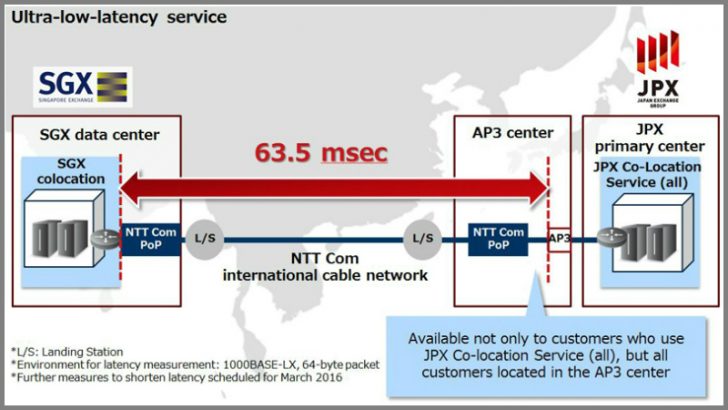
In the world of high frequency trading shaving a small amount of the latency on connections between financial centres can make a considerable difference. NTT has announced an admittedly small decrease in the latency between Singapore and Japan with a change in configuration. The reduction is just 0.2 milliseconds, from 63.7 milliseconds to 63.5 milliseconds and is being achieved between JPX’s Access Point 3-equipped data center (AP3 center) and the Singapore Exchange (SGX)
To make this reduction NTT Communications has added a PoP (Point of Presence) to the AP3 data centre and located it physically adjacent to the structured cabling to ensure that the least number of connections from end to end is achieved. The new latency was measured using a 1Gbps test cable and 1000Base-LX/64-bite packet environment. It should be noted however that clients will achieve a latency that is dependent upon the network equipment they utilise for their connections. In other words, actual latency from server to server is likely to be higher than this.
The low latency is achieved using the submarine cable directly connecting Japan and Singapore via the shortest route. The Asia Submarine Cable Express (ASE) provides a key advantage over competitors and this slight improvement in design helps not only financial traders but also other companies looking take advantage of low latency between the two nations
This upgrade will appeal to multi-national companies delivering co-location services in the APAC region. They can now deliver services between Singapore and Japan for widely dispersed disaster recovery options including high-speed data replication. NTT Communications are due to integrate the co-location services for its Tokyo and Osaka exchanges and the the integration of the Tokyo Stock exchange into the JPX platform later in 2016. This announcement could mean that there will be some interesting network design changes for some customers looking to leverage the low latency link.
Conclusion
While the decrease in latency between Japan and Singapore may not seem significant, for companies relying on low latency for financial transactions this can make a considerable difference. What is interesting is that NTT does not appear to be offering this as a service upgrade but rather as a new service. This means that existing users of the link will need to sign new agreements to take advantage of the lower latency and probably pay higher charges.
NTT Communications clearly feels that such a small reduction in latency can make a significant difference to some customers. The reality is that if one financial trading customer takes advantage of the new link then it is likely that others will follow suit in order not to be disadvantaged.


























